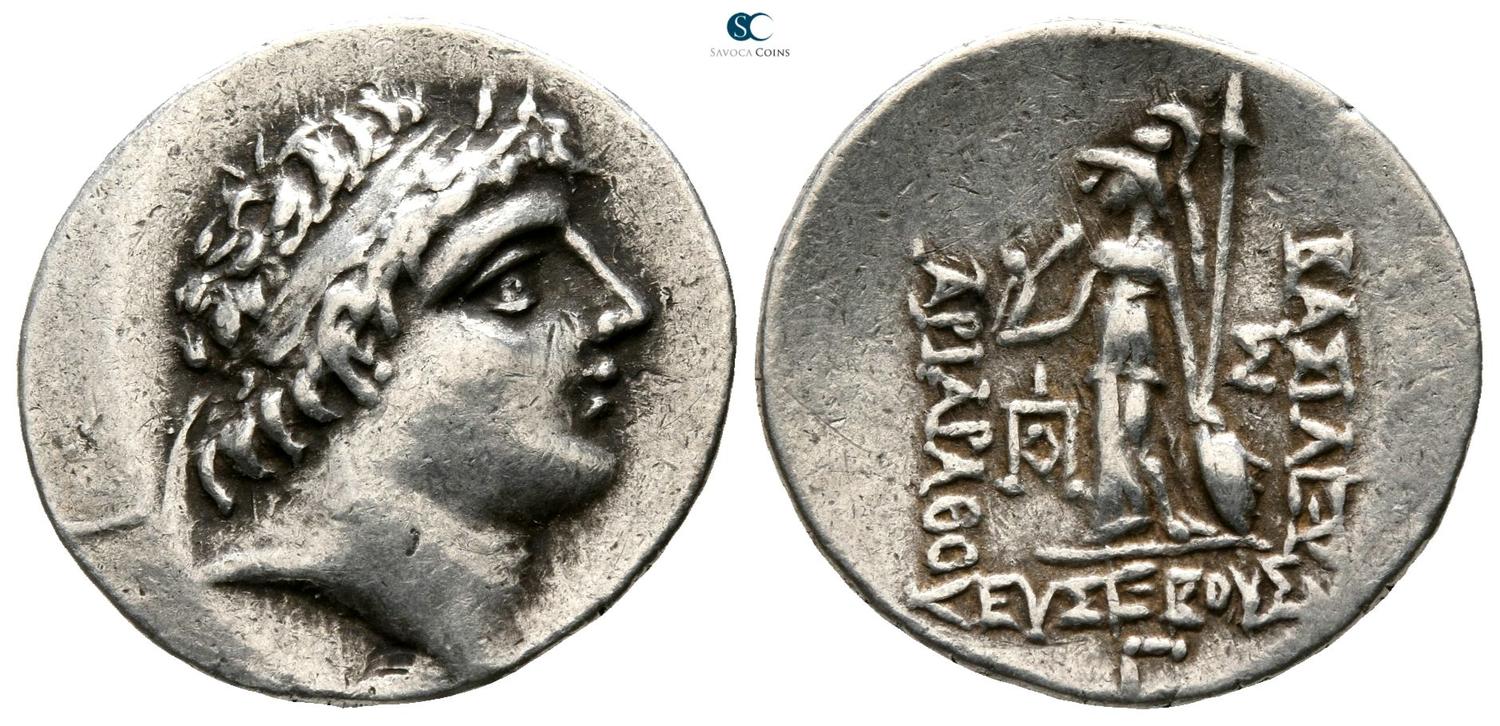Eusebeia (Ariarathes IX), silver, drachms (Ariarathes IX/Athena nicephorus) (101-98 BCE)
From SILVER
101 BCE - 98 BCE Silver 3,539 kg
Description
| ObverseInscription or printing placed on the obverse.: | Diademed head right |
| ReverseInscription or printing placed on the reverse.: | ΒΑΣΙΛΕΩΣ ΑΡΙΑΡΑΤΟΥ ΕΥΣΕΒΟΥΣ (Greek).Athena standing left, holding Nike, spear and shield, monogram in inner left field, Σ in inner right, date Γ in exergue |
Mint and issuing power
| MintIdentifies the place of manufacture or issue of a numismatic object.: | Eusebeia | Ancient regionAncient region.: | Cappadocia | Modern countryModern country: Turkey | AuthorityIdentifies the issuing power. The authority can be "pretended" when the name or the portrait of X is on the coin but he/she was not the issuing power. It can also be "uncertain" when there is no mention of X on the coin but he/she was the issuing power according to the historical sources: | Ariarathes IX Eusebes Philopator (king of Cappadocia, c.100-c. 85 BC), Cappadocian kingdom |
Chronology
| FromIdentifies the initial date in a range assigned in a numismatic context. | 101 BCE | toIdentifies the final date in a range assigned in a numismatic context.. | 98 BCE | PeriodTime period of the numismatic object.: Hellenistic 323-30 BC |
Physical description
| MetalThe physical material (usually metal) from which an object is made.: | Silver |
Median weightMedian of the weights of numismatic objects (in grams). in grams | 4.10 | DenominationTerm indicating the value of a numismatic object. Examples: tetradrachm, chalkous, denarius.: | drachma |
StandardStandard.: | Attic |
Image

H272 Eusebeia Ariarathes VIII.jpg [1]
References
| Die study referencePublication of the study: | Mørkholm 19681Mørkholm 1968 | ||
| Coin series referenceReference to coin series study: | Sear II2Sear II, n° 7297, RQEMH3RQEMH, n° 272 | ||
Obverse dies distribution
| FrequencyFrequency of specimen in distribution. ᵖ | Number of obversesNumber of obverse dies. ᵖ (o) | % (o) | Number of coinsNumber of coins. (n) | % (n) | Die nameName(s) of the die(s). |
| 1 | 15 | 46.88 | 15 | 17.65 | 2, 3, 7, 9, 10, 12, 13, 15, 22, 23, 24, 28, 29, 30, 32 |
| 2 | 3 | 9.38 | 6 | 7.06 | 11, 17, 25 |
| 3 | 6 | 18.75 | 18 | 21.18 | 4, 14, 19, 21, 26, 27 |
| 4 | 2 | 6.25 | 8 | 9.41 | 18, 20 |
| 5 | 4 | 12.5 | 20 | 23.53 | 5, 6, 16, 31 |
| 8 | 1 | 3.13 | 8 | 9.41 | 1 |
| 10 | 1 | 3.13 | 10 | 11.76 | 8 |
| Total | 32 of 32 | 100.02 | 85 of 85 | 100 |
Reverse dies distribution
no distribution is available
Quantification
| Number of obversesNumber of obverse dies. ᵖ (o) | 32 | Number of singletons (o1)The number of singleton coins. ᵖ | 15 |
| Number of reverse diesNumber of reverse dies. (r) | 61 | Number of coinsNumber of coins. (n) | 85 |
| Coins per obverse dieNumber of coins per obverse die. (n/o) | 2.66 | Coins per reverse dieNumber of coins per reverse die. (n/r) | 1.39 |
| Reverse per obverse ratioRatio of obverse dies divided by reverse dies. (r/o) | 1.91 | Percentage of singletons (o1)number of coins (n) divided by the number of singletons (o1) ᵖ | 46.88 % |
| Original number of dies (O) (Carter 1983 formula)The estimation of the number of coins according to Carter 1983 ᵖ | 43.16 | Coins struck if 20,000 as average productivity per dieCoins made if the average productivity for obverses (according to Carter) is 20,000. ᵖ | 863,200 |
| Original number of dies (O) (Esty 2011 formula)The estimation of the number of coins according to the singleton formula in Esty 2011 ᵖ (O) | 51.32 | Survival rate if 20,000 as average productivity per dieSurvival rate if average productivity is 20,000. ᵖ | 0.00010 |
| Coverage (o = % of O) (Esty 1984 formula)Esty 1984 - coverage (% of O) ᵖ (o = % of O) | 82.35% | Die productivity if survival rate 1/2,000Average productivity if survival rate is 1/2,000. ᵖ | 3,938.83 |
| Weight of silver (in kg) if 20,000 coins per die (O = Carter formula)Carter 1983 * Median weight * 20000 (*10 if gold or electrum) ᵖ | 3,539 kg <br /> 3,539 kg | Die productivity if survival rate 1/5,000Average productivity if survival rate is 1/5,000. ᵖ | 9,847.08 |
Remarks
Most likely one single workstation
References
- ^ Mørkholm, Otto (1968), "The Coinages of Ariarathes VIII and Ariarathes IX of Cappadocia", in Essays Presented to Stanley Robinson, Oxford, p. 241-58, pl. 30-33.
- ^ Sear, David R. (1979), Greek coins and their values. Vol. II, Asia and North Africa, London, xlviii, p. 317-762
- ^ Callataÿ, François de (1997), Recueil quantitatif des émissions monétaires hellénistiques, Numismatique Romaine, Wetteren, X + 341 p.